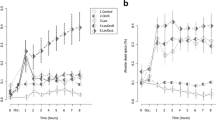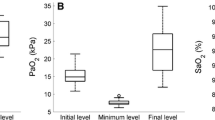Abstract
The influence of positive end expiratory pressure (PEEP) on the fluid filtration rate (FFR) in the pulmonary circulation has been the subject of considerable investigation but data are conflicting. We studied twentynine isolated rabbit lung preparations, FFR was sensed by a force transducer. Autologous blood was used to prime the perfusion circuit. Hydrostatic oedema was achieved by increasing the left atrial pressure to 16 mmHg. In order to bring about increased membrane permeability oleic acid was injected through the pulmonary artery. Increasing and decreasing levels of PEEP at 0, 5, 10 and 15 cm H2O were each used for ten minutes in each of three experimental models. The FFR, pH, mean pulmonary arterial pressure (MPAP), mean left atrial pressure (MLAP), PaO2, PaCO2 and oncotic pressure were measured in each experiment. There was a significant correlation between PEEP and FFR (+0.94) in non-oedema lungs. With no PEEP the FFR was 0 g/min and with 15 cm of PEEP it increased to 0.07 g/min, on removing the PEEP the FFR returned to 0 g/min. In the hydrostatic lung oedema model the correlation was also significant but negative (r=−0.94). With no PEEP the FFR was 0.33 g/min, with PEEP of 15 cm H2O it decreased to 0.08 g/min. No correlation between PEEP and FFR was found in the oleic acid preparation. In the normal lung PEEP increases capillary hydrostatic pressure and total lung vascular area and decreases interstitial pressure. It is by these mechanisms that PEEP causes an increase in FFR. In the hydrostatic oedema model PEEP decreases FFR by increasing the interstitial pressure and by decreasing the total lung vascular area. In the oleic acid preparation the coefficient of filtration is so large that small changes in pressure or vascular area do not modify the FFR. We suggest that PEEP may be beneficial by decreasing FFR in hydrostatic lung oedema, but it may increase the FFR in the normal lung, while having no effect in oleic acid lung injury.
Similar content being viewed by others
References
Leftwich EI, Witorsch P (1973) Positive and expiratory pressure in refractory hypoxemia: a critical evaluation. Ann Intern Med 79:187–190
Garrard CS, Shah M (1978) The effect of positive expiratory airway pressure on Functional Residual Capacity in normal subjects. Crit Care Med 6:320–322
Hammon JW, Wolfe WS, Moran JF (1976) The effects of positive end-expiratory pressure on regional ventilation and perfusion in the normal and injured primate lung. J Thorac Cardiovasc Surg 72:680–683
Katz JA, Ozanne GM, Zinn SE (1981) Time course and mechanisms of lung volume increase with PEEP in acute pulmonary failure. Anesthesiology 54:9–15
Starling E (1986) On the absorption of fluid from the connective tissue spaces. J Physiol 19:312–319
Landis EM, Pappenheimer JR (1963) Exchange of substances through the capillary walls. Handbook of Physiology Society Washington, DC, pp 961–1010
Caldini P, Leith JD, Brenan MJ (1975) Effect of continous positive pressure ventilation (CPPV) on edema formation in dog lung. J Appl Physiol 39:672–685
Toung TJ, Saharia P, Mitzner WA (1978) The beneficial and harmful effects of positive end-expiratory pressure. Surg Gynecol Obstet 147:518–522
Pang LM, Rodriguez F, Stalcup SA (1978) Effects of hyperinflation and atelectasis on fluid acumulation in the puppy lung. J Appl Physiol 45:284–290
Demling RH, Staub NC, Edmonds LH (1975) Effect of end expiratory airway pressure on accumulation of extravascular lung water. J Appl Physiol 38:907–911
Miller WC, Rice DL, Linger KM (1981) Effect of PEEP on lung water content in experimental noncardiogenic pulmonary edema. Crit Care Med 9:7–17
Dunegan LJ, Knight DC, Harken A (1975) Lung water thermal volume in pulmonary edema. Crit Care Med 181:809–816
Goldberg HS, Mitzner W, Batra G (1977) Effect of transpulmonary and vascular pressures on rate pulmonary edema formation. J Appl Physiol 431:14–26
Ashbaugh DC, Petty TL, Bigelow DB (1969) Continuous positive pressure breathing (CPPB) in adult respiratory distress syndrome. J Thorac Cardiovasc Surg 57:31–41
Kumar A, Falke KJ, Feffin B (1970) Continuous positive pressure ventilation in acute respiratory failure. N Engl J Med 283:1430
Sánchez de León R, Orchard CH, Chakrabarti MK (1983) Effect of changes in pleural pressure on fluid filtration rate in expanded and atelectatic rabbit lungs. Acta Anaesthesiol Scand 27:294–302
Goshy M, Lai-Fook SJ, Hyatt RE (1979) Perivascular pressure measurements by wick-catheter technique in isolated dog lobes. J Appl Physiol 465:950–959
Lunde PK, Waaler BA (1969) Transvascular fluid balance in the lung. J Physiol 205:1–12
Sánchez de León R, Orchard CH, Chakrabarti MK (1982) Effect of hypoxia on fluid filtration rate during forward and reverse perfusion of isolated rabbit lungs. Cardiovasc Res 16:711–719
Lai-Fook SJ, Toporoff B (1980) Pressure-volume behavior of perivascular interstitium measured in isolated dog lung. J Appl Physiol 486:939–943
Hauge A, Nicholaysen G (1971) Studies on transvascular fluid balance and capillary permeability in isolated lung. Bull Physiopathol Respir 7:1197–1203
Sánchez de León R, Paterson L, Sykes MK (1982) Changes in colloid osmotic pressure and plasma albumin concentration associated with extracorporeal circulation. Br J Anaesth 54:465–472
Slutsky RA, Higgins CB (1982) Intravascular and extravascular pulmonary fluid volumes. Response to sustained left atrial hypertension. Cardiovasc Res 17:113–118
Sánchez de León R, Orchard CH, Chakrabarti MK (1985) Effect of plasma colloid osmotic pressure on fluid filtration rate in isolated rabbit lungs. Crit Care Med 138:668–672
Hurley JV (1978) Current views on the mechanism of pulmonary edema. J Pathol 125:59–71
Mitzner W, Batra G, Golberg H (1976) Lung inflation and extravascular fluid accumulation. Circulation 54:14–22
Annest SJ, Gottlieb M, Paloski WH (1980) Detrimental effects of removing and expiratory pressure prior to endotracheal extubation. Ann Surg 191:539–545
Staub NC (1974) Pulmonary edema. Physiol Rev 54:678–758
Fishman AP (1972) Pulmonary edema. The water exchanging function of the lung. Circulation 46:390–397
Robin ED, Cross CE, Zelis R (1973) Pulmonary edema. N Engl J Med 288:239–243
Lai-Fook SJ (1982) Perivascular interstitial fluid pressure measured by micropipettes in isolated dog lung. J Appl Physiol 521:9–16
Mellins RB, Levine DR, Skalak R, Fishman A (1969) Interstitial Pressure of the lung. Circ Res 24:197–204
Shapiro BA, Cane RD, Harrison RA (1984) Positive end expiratory pressure therapy in adults with special reference to acute lung injury: a review of the literature and suggested clinical correlations. Crit Care Med 12:127–132
Staub NC (1980) The pathogenesis of pulmonary edema. Prog Cardovasc Dis 23:53–59
Canada E, Benumof JL, Tousdale FR (1982) Pulmonary vascular resistance correlates in intact normal and abnormal canine lungs. Crit Care Med 10:719–724
Guyton AC, Lindsey AW (1959) Effect of elevated left atrial pressure and decreased plasma protein concentration on the development of pulmonary edema. Circ Res 7:649–653
Guyton AC, Taylor AE, Granger HJ (1975) Types of tissue pressure and their significance in circulation physiology. Dynamics and control of the body fluids. Saunders, Philadelphia, pp 18–25
Author information
Authors and Affiliations
Additional information
This research has been partially supported by Conicit, Venezuela Grant N.S1-1378
Rights and permissions
About this article
Cite this article
Zabner, J., Angeli, L.S. & Sánchez de León, R. The effects of graded administration of positive end expiratory pressure on the fluid filtration rate in isolated rabbit lungs, using normal lungs, hydrostatic oedema lungs and oleic acid induced oedema. Intensive Care Med 16, 89–94 (1990). https://doi.org/10.1007/BF02575300
Received:
Accepted:
Issue Date:
DOI: https://doi.org/10.1007/BF02575300




